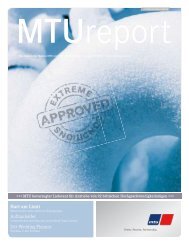You also want an ePaper? Increase the reach of your titles
YUMPU automatically turns print PDFs into web optimized ePapers that Google loves.
Interview<br />
Jim Brewin (left) is a development engineer at Hitachi Rail Europe. In an interview, he explains the requirements which Hitachi and <strong>MTU</strong> have to meet in<br />
the IEP project.<br />
"We are being paid for availability and reliability"<br />
Mr. Brewin, as development engineer at Hitachi Rail Europe you were responsible<br />
for the technical side of procurement of the generator units within the IEP project.<br />
What were the key requirements demanded of the Powerpacks?<br />
The available installation space was the starting point for all technical requirements as far<br />
as the train designers at Hitachi were concerned. The designers at our Kasado Factory in<br />
Japan defined what we required with regard to external dimensions, power output and<br />
interfaces between train and generator unit. From a maintenance viewpoint, we decided<br />
that the simplest solution is a module that we can remove and refit quickly and easily –<br />
like a pit-stop in Formula 1.<br />
What were the arguments in favor of the Powerpack?<br />
There were pros and cons with every potential supplier. With some, the technical solution<br />
was better, with others, the support services offered. For us it was important that the<br />
solution was well-balanced. Hitachi worked out the ideas together with the bidding<br />
suppliers rather than rigidly specifying, “This is exactly how it should be done” – instead,<br />
we expected suggestions from the potential suppliers. Through that very close<br />
collaboration process, we built up a very good relationship with <strong>MTU</strong> and are confident<br />
that the Powerpack will be a success.<br />
Why did Hitachi opt for a 700-kilowatt Powerpack instead of choosing the standard<br />
560-kilowatt version?<br />
The simple answer is more flexibility and greater redundancy. The requirement for the<br />
engine output power is 560 kilowatts. But if, for example, the train leaves a station behind<br />
schedule or an engine fails, the 700-kilowatt Powerpack gives reserves to make up the<br />
time where possible. It also allows the flexibility of running key auxiliary systems such as<br />
air conditioning without limiting the traction power.<br />
Hitachi also had strict demands regarding low levels of noise and vibration<br />
from the generator units. Why?<br />
The European TSI standard (Technical Specifications for Interoperability) is very, very<br />
strict. For example, when a train pulls out of a station, it must not exceed a specific<br />
volume level. As well as that, the passengers want to feel as little vibration as<br />
possible. Meeting those demands is a significant challenge for <strong>MTU</strong> and Hitachi. We<br />
carried out very thorough bench-tests in Japan and are working hard with <strong>MTU</strong> at<br />
minimizing the noise and vibration.<br />
How will Hitachi and <strong>MTU</strong> work together in the future?<br />
The IEP contract includes maintaining the trains for 27½ years. Hitachi is the general<br />
contractor and <strong>MTU</strong> is responsible for maintaining the generator units. The Powerpack<br />
experts are at <strong>MTU</strong> and we want to ensure they are involved over the full term. That<br />
is the only way we will always be able to offer maximum availability and reliability.<br />
And that is what we are being paid for. <strong>MTU</strong> has been able to demonstrate its<br />
maintenance contract expertise over many years in the previous HST (High Speed<br />
Trains) project in the UK. In addition, some of our colleagues have previously worked<br />
with the <strong>MTU</strong> service organization and have been favorably impressed. Those were<br />
the factors that persuaded us. There are, of course, still some challenges to overcome,<br />
but the basic outlines of the collaboration are clear and we have a very good solution<br />
for the Intercity Express Programme.<br />
<strong>MTU</strong> Report 03/12 I 19



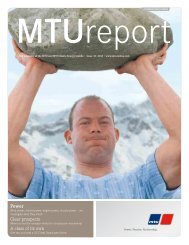

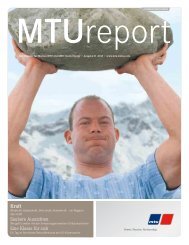
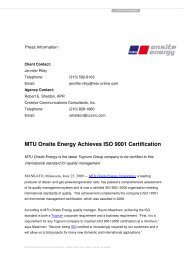

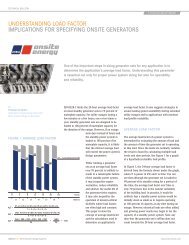
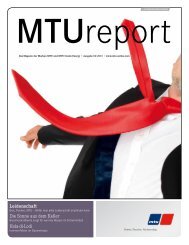

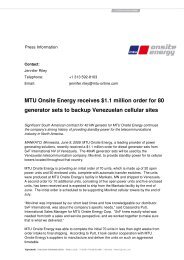

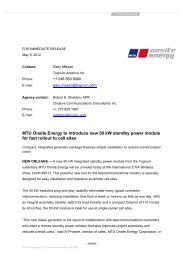

![Full power range of diesel generator sets [PDF] - MTU Onsite Energy](https://img.yumpu.com/28297693/1/190x253/full-power-range-of-diesel-generator-sets-pdf-mtu-onsite-energy.jpg?quality=85)
